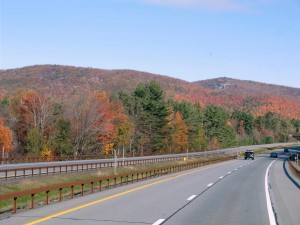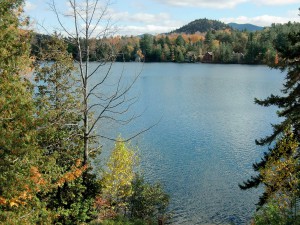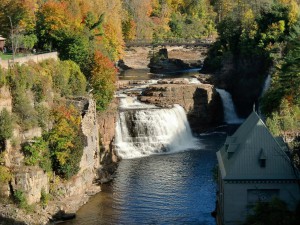EXOLORING NEW YORK – THE ADIRONDACKS
EXOLORING NEW YORK
This is the sixth in a series of articles about traveling the byways of New York State
THE ADIRONDACKS
By Charles N. Stevens
Photos by Dolores Seidman
With only a few puffy clouds floating in the morning sky, it’s a perfect day to explore the Adirondacks. The scattered peaks of these mountains occupy the northeastern portion of New York State and compose the largest natural wilderness region in the eastern United States.
We leave Saratoga Springs for the day, the town famous for its hot springs and one of the oldest horse racing tracks in the United States. We begin by cruising down Saratoga Springs’ main street with its quaint 19th century brick buildings and its contrasting ultra-modern city hall.
Once out of town and heading up Highway 9, we begin to see more displays of autumn leaves. We become what the easterners call “leaf peepers.” The hills and ridges are now in full color, the sun filtering down through the thin-trunked trees, dappling the carpet of fallen leaves beneath them.
We cross the mirror-like Hudson River and are soon in Adirondack State Park. Reddish maple and bright yellow aspens and birch contrast with the darker pines among them. We’re delighted that the hills inflatable water slide are burnished with shades of yellow and orange, the roadside softened with deep red sumac. The explosion of color is one reason why we’re here, why we flew 2000 miles to see it. A few low clouds swirl among the peaks. We’re surprised to see a group of wild turkeys strolling on a grassy median.
As we pass Schroon Lake, our guide tells us that there are over three thousand lakes and ponds within the Adirondack State Park. More low clouds and tongues of fog lick through parts of the forest, giving us an ever-changing scene. Some of the bare rounded peaks are so high they are above the timber line. The highest peaks in the Adirondacks are close to five thousand feet in elevation. The road follows a stream strewn with gray boulders, rapids and miniature waterfalls. Ahead of us, fallen leaves cover the road, cars racing through them setting them swirling into a twisting yellow blizzard. Glacier-scoured hillsides stand smooth and gray. During the Ice Age the vast Laurentian Glacier shaped the landscape of New York, carving canyons, scraping hillsides and dumping rocks and soil to form long moraines.
We pass several trailheads, clusters of cars parked at each one. We learn that there are over two thousand miles of trails in the park, some leading to the tops of peaks. We won’t be taking any trails today, our bus rolling right past them.
As our altitude increases the autumn colors are nearly over, the trees stark and bare or with only a few leaves left. We come upon several signs warning motorists to watch out for moose, but we never see any of the majestic animals.
Nearing Lake Placid, site of the 1932 and 1980 Winter Olympics, we spot two huge ski jumping structures looming conspicuously out of the forest. Soon we arrive at Lake Placid Village where our bus parks near the Olympic Center and where we get off to explore the town. We zip up our jackets against the chilly air. To take a break from the cold, Dolores and I dodge into the lobby of the Golden Arrow Hotel where a fire flickers in the fireplace and great windows look out on the deep blue of Mirror Lake. Below is a small sandy beach, blue beach lounge chairs, all unoccupied on such a cold day, lined up on the shore. The rippling water is glassy clear, so much so that when a flotilla of ducks cruises by we can easily see their feet paddling beneath them. Many hotels occupy the shores of the lake with forested hills rising beyond them.
Leaving our comfort, we walk along the main street of the village, noting its many quaint shops, restaurants and hotels. We enter the small public library, its limited space packed with books and the smell of books.
On the road again, we skirt beautiful Saranac Lake where Robert Louis Stevenson once had a cottage. We pass farms with white Dutch barns and sand dunes left over from the glaciers. The shadows of clouds roam over the mountains where dark pines stand out among the hazy branches of leafless trees. From high points we look out over seemingly unending miles of forests and mountain ridges.
I’m disappointed that we don’t see more than a quick view of silver-blue Lake Champlain. On our trip to France we had seen a bust of Champlain in Honfleur where he was born, so we wanted to see the great lake named after him. The lake is 120 miles long and is the largest in the United States other than the Great Lakes. It drains into the Saranac River and eventually the Hudson.
Our next stop is at Ausable Chasm where the swift water of the Ausable River roars and tumbles over chaotic layers of sandstone. The muted thunder of the plunging water and the cool wind that it stirs up is exciting as well as beautiful. We stand on a bridge spanning the gaping chasm admiring it all.
Our bus cruises by Lake George, a body of water 32 miles long but only 3 miles wide. It was named after King George II and contains 365 small islands. At the south end, large tourist boats, looking much like steamships, wait at the docks. Cumulus clouds float in a clear sky, and whitecaps stirred by the wind animate the surface of the lake.
On our way back to Saratoga Springs we relax and take in the scenes passing our bus window. A mound of weathered sticks appears in a still pond, the work of the local beavers. Neat stacks of logs stored for the winter occupy sheds at the backs of farm houses.
At a Golden Coral restaurant we stuff ourselves before driving to our hotel. It had been a long but stimulating day of autumn leaves, sapphire-blue lakes, unending forests, waterfalls and picturesque farmland, just a sampling of a portion of northeast New York.

The highway leads us into the Adirondacks where the trees are burnished with autumn.

We enjoy a respite by looking out over Lake Placid.

The roaring of the falls at Ausable Chasm is captivating.

Trees are in the true fall colors near the chasm.



